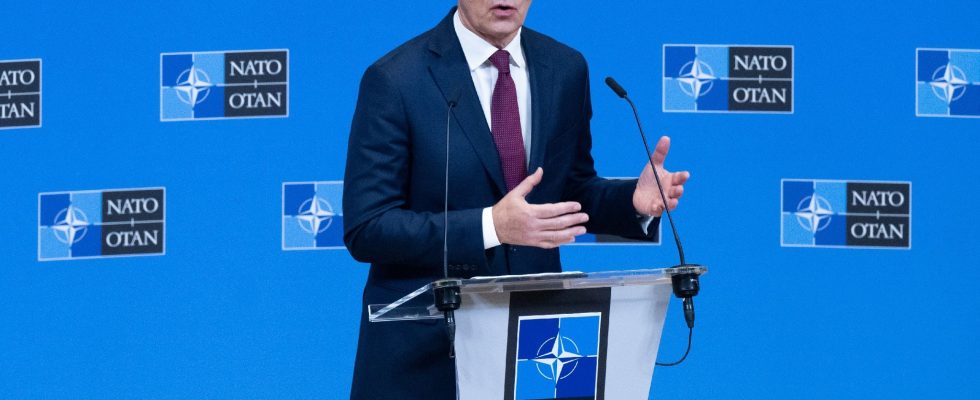This is far from the first time that Donald Trump has attacked the allies of the North Atlantic Treaty Organization. Its latest release, Saturday February 10, is no less resounding. During a meeting in South Carolina, the former president, a candidate again in 2024, reported a conversation he would have had with a head of state of a NATO member country, without naming him.
“One of the presidents of a big country stood up and said, ‘well, sir, if we don’t pay and we’re attacked by Russia, will you protect us?'” told the billionaire, before revealing his answer: “No, I would not protect you. In fact, I would encourage them to do what they want to you. You must pay your debts.”
His statement sparked reactions on both sides of the Atlantic. “Any suggestion that Allies will not defend each other undermines all of our security, including that of the United States, and exposes American and European soldiers to increased risk,” said the Secretary General of NATO, Jens Stoltenberg. More complexly, the debate on the insufficient participation of European countries in financing NATO is an “old sea serpent”, according to Jean-Sylvestre Mongrenier, research director at the Thomas More Institute. “The United States has always tried to bring this subject into the debate, even if it has never been said so thunderously,” adds the researcher. So, how is NATO financed and by whom? L’Express takes stock.
Direct funding from the 31 members
The 31 member states contribute directly to the NATO budget. According to the site of NATO, direct contributions are the funds that Allies pay for the execution of jointly financed budgets and programs. In 2023, the Organization’s direct spending exceeds 3.3 billion euros, or barely 0.3% of the allies’ total defense spending. This direct funding is used, among other things, to finance the Organization’s permanent military command structure, ongoing operations and missions, or even essential military infrastructure (notably naval bases and air bases).
This financing of NATO institutions and structure is negotiated every two years, as is the share of each country. The United States and Germany are the main contributors, each with 16.2%, followed by the United Kingdom with 11.2%, France (10.4%) and Italy (8.7%) . “On this type of financing, there is no real imbalance, since the United States hardly finances more than Germany or the United Kingdom,” underlines Jean-Sylvestre Mongrenier. “Questions, even debates, however, regularly emerge on the issue of indirect financing.”
The 2% of GDP rule
When the NATO Council decides, by consensus, to engage in an operation or mission, no obligation is placed on members to contribute to it. Since NATO does not have its own armed forces, it is the allies who put troops and equipment at its disposal on a voluntary basis. During his 2016 election campaign and during his term as president, Donald Trump regularly targeted Germany on this subject, declaring that the country would have to pay “large sums of money” to make up for the delay in this indirect financing.
“The greatest imbalance nevertheless comes from the fact that not all allies respect the rule according to which they must devote 2% of their GDP to military matters,” comments geopolitics doctor Jean-Sylvestre Mongrenier. The objective: that “operational availability remains assured across the Alliance”. But the value also serves as an indicator of the political will of each state to contribute to the overall effort. On its site, the transatlantic alliance emphasizes that the sum of the GDP of all member countries excluding the United States is almost equal to the wealth of the United States. But these countries, together, spend half as much on defense as Washington. Out of 31 states, only 11 follow the 2% rule. Among which, in the lead: Poland (3.9%), the United States (3.5%), Greece (3%) and Estonia (2.7%). While Spain (1.3%), Belgium (1.1%) and Luxembourg (0.7) are far from it.
“It’s a structural problem within the alliance,” notes Jean-Sylvestre Mongrenier. “It’s what we call “burden sharing” [NDLR, le partage du fardeau, en anglais]. As early as the 1970s, American allies insisted that Europeans should participate more in the alliance. Before Trump, in a less virulent and more diplomatic way, there had already been several warnings, notably from Robert Gates, Secretary of State for Defense under Bush Jr., but also Obama. Taking into account these indirect expenses, The American budget allocated to NATO represents more than 70%, compared to 30% for the rest of European countries, creating potential imbalances, particularly in the choices and content of the Alliance’s missions.
.
